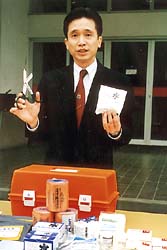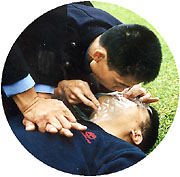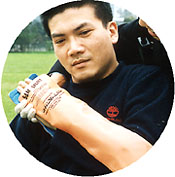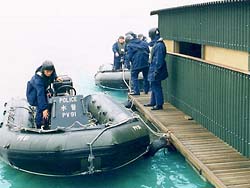



















|
Real life emergency training essential for police instructors | |
 Acting Sergeant Chan Hon-kuen (right) found himself struggling to save a man's life during first-aid training with an emergency ambulance team |
ARRANGED by the Hong Kong Red Cross, eleven
instructors from the Training Development Bureau's First Aid Training Division were attached to
different ambulance depots of the Fire Services Department as part of a two-day practical workshop
geared to enhance and update their first-aid knowledge and instruct them in the use of modern
emergency medical equipment such as the automated external defibrillator for patients suffering from
cardiac arrest.
The attachment gave the instructors a chance to work directly with, and experience first-hand the life-saving operations carried out by emergency ambulance teams who on a daily basis respond to urgent situations, traffic accidents and crime scenes where people are frequently ill, injured, suffering from collapse or seriously wounded. |
|
Indeed, during his two-day training/deployment, acting Sergeant Chan Hon-kuen found himself involved in a life and death situation when the ambulance team he was accompanying responded to a traffic accident in which a taxi driver was physically beaten by an individual with whom he was involved in a vehicular crash. Leaving policing duties to his Force colleagues, acting Sergeant Chan, along with other members of the ambulance team, tried his best to provide emergency first-aid treatment to the taxi driver who later died in hospital. "Police officers are usually the first to reach emergency scenes. Consequently this type of training is essential for our instructors to gain practical experience," said Training Wing's acting Chief Inspector Stephen Ma Chak-wah, head of the First Aid Training Division. "They in turn will train frontline police officers who also need to practice and upgrade their first-aid skills. To this end, the Cardio Pulmonary Resuscitation training programme which over the past three years has been providing frontline officers with first-aid training, has evolved into Phase II of the programme - Basic Life Support/CPR Training." Phase II training includes the introduction and use of the new Force standard first-aid kits; Unconscious Patient Management where officers learn and practice the skill of dealing with subjects who are unconscious; as well as training in how to conduct an effective body survey to determine the extent of injury to casualties. "Head-to-toe body search skills are particularly useful in traffic accidents, personal injury cases and incidents involving collapse," said acting Chief Inspector Ma. "Frontline officers must learn how to perform a head-to-toe body survey on an accident victim checking for bleeding, fractures and so forth. At the same time, because traffic accidents often lead to spine and neck injuries, it is extremely important our officers be trained to deal with these." | |
| New Force Standard First Aid Box | |
|
THE newly outfitted Force Standard First Aid Box is
in the process of being placed in all PTU platoon vehicles, EU cars, Marine Police launches and
special units' vehicles such as those operated by PTI of PTU.
The new kit contains 24 first-aid items, some never before used by Force members, such as the chest seal, face shield, Sam splint, scissors, disposable blanket and cold pack. "The chest seal is applied to gunshot and other open wounds to that area, while plastics bags and cold packs are particularly useful in traffic accidents and cases of wounding to stop bleeding and protect damaged limbs," said acting CIP Ma. "Scissors perform a variety of functions from cutting dressings to cutting accident victims out of car safety belts while anticipating the ambulance's arrival." Different from the traditional wooden splint, the new Sam splint is plastic wrapped and can be easily twisted into a fixed position to stabilise fractured limbs. The disposable blanket, made of aluminium, is very lightweight and suitable for sea rescues, traffic accidents and emergencies that happen in cold weather. |
 Acting CIP Ma: "To date 4,342 Uniform Branch JPOs (and 783 auxies) have been trained to use the items in the newly outfitted standard first-aid box" |
|
The kit also contains a specially designed first-aid handbook with 13 common rescue methods to help officers reinforce the techniques while on route to the scene. Other items in the kit include: gloves, penlight, aqueous solution, basin kidney shaped basin, tweezers, safety pins, waterproof adhesive tape, water gel to soak burn dressings and a comprehensive selection of adhesive bandages, gauze and dressings for all sorts of wounds and injuries. | |
  Demonstrating the new face shield (left) and SAM splint |
Said Mr Ma: "The introduction of a face shield (requested by participants in Phase I CPR training), can protect officers from coming into contact with germs that cause transmissible diseases such as hepatitis and AIDS. The shield is also expected to be available to all Uniform Branch officers involved in operational duties in the coming months. A message will be issued on this matter by the Chief Supplies Officer, Police Store." |
| |
 Marine West Division police prepare to move the hide to Mai Po |
TEN officers from Marine West Division (MWDIV)
carried off a special mission last month when they helped the World Wide Fund for Nature Hong
Kong (WWF HK) tow a floating bird-watching hide from Tsim Bei Tsui and anchor it in the shallow
waters amid the mangroves of the Mai Po Marshes Wildlife Education Centre and Nature Reserve.
Manufactured by a shipbuilding company in Aberdeen (payed for by a donation from the Rotary Club of Hong Kong), the floating hide was brought from Deep Bay to Tsim Bei Tsui by a MWDIV jetboat. |
|
This was the third of three hides that Marine officers assisted the WWF HK in placing and will help meet the growing demands of an increasing number of visitors to the Reserve. Last year, more than 40,000 people visited Mai Po, including students from 400 schools. Measuring 20 metres in length and three metres in height, the floating hide can accommodate more than 50 bird-watchers and nature enthusiasts at one time. Said DVC MWDIV Ling Wai-po: "Due to the low water level in the mangroves, only our Silinger boats with flat bottoms and shallow draught can venture through the marshes. We carefully studied this year's tidal flow and found its level would rise to at least 2.7 metres at 11pm on 27 February - the only day that provided us with a tide high enough for towing the bird-watching hide into position. Missing this opportunity would mean waiting until late April." Beginning at 9pm, Marine officers rigged up the hide with one Silinger deployed to tow it to the marshes, while two other small boats flanked and provided balance as it was moved towards Mai Po - a two-hour journey. Once there, World Wide Fund staff helped anchor it into precise position among the Mai Po marshlands and connect the floating bridge which leads visitors onto the hide - all in the dark and pouring rain. Mai Po, bordering Deep Bay in northwest New Territories, is an important nature reserve where migrating birds rest and feed before continuing on their long-distance journeys. Though best known for birds, Mai Po is a wetland area of international importance supporting a wide range of habitats and wildlife. At least 325 species of birds, 400 species of insects, 90 species of marine invertebrates and over 50 species of butterflies have been recorded there. Otters, leopard cats and other mammals are also found there. Every winter, over 50,000 water birds visit Deep Bay, including such endangered species as Saunders' Gulls and Black-faced Spoonbills. With an estimated 300 to 350 Black-faced spoonbills remaining globally, Mai Po is the winter home for 25 per cent of its world population. Mangroves are another distinctive feature of Mai Po. They are becoming increasingly rare but are vital to certain species of fish, shrimps and crabs which feed on fallen mangrove leaves. Six species of mangroves grow around the edge of Deep Bay covering an area of around 300 hectares. This is the largest stand of mangrove in Hong Kong, and the sixth largest protected stand in China. A stainless steel plaque on the wall of the newest floating hide is in appreciation of the work of Marine Police officers. | |

![]()
